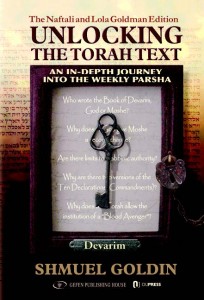Unlocking the Torah Text— Devarim: An In-depth Journey into the Weekly Parsha
 Unlocking the Torah Text—Devarim: An In-depth Journey into the Weekly Parsha
Unlocking the Torah Text—Devarim: An In-depth Journey into the Weekly Parsha
By Rabbi Shmuel Goldin
OU Press/Gefen Publishing House
Rabbi Shmuel Goldin’s Unlocking the Torah Text—Devarim, the fifth and final volume of this popular series, is a welcome addition to the world of Torah commentary.
Following the pattern of his earlier volumes, this new book presents numerous studies on each parashah in the Book of Devarim. After opening each study with questions that strike critical, fundamental issues in the text, Rabbi Goldin offers a variety of approaches to the questions raised, quoting and explaining a wide spectrum of rabbinic sources, from the classical to the modern. To these, he often adds original approaches as well. Finally, many of the studies close with a section of “Points to Ponder,” specifically designed to encourage continued thought, discussion and debate on connections between the Torah section under “Study” and relevant, current issues.
Throughout this volume, Rabbi Goldin urges the reader to be mindful of the unique, multi-layered nature of the last book of the Torah. Devarim contains critical elements of God’s unfolding law, but as Rabbi Goldin explains from the outset, it also chronicles the poignant human drama of the final five weeks of Moshe’s life. Ever-present beneath the surface of the text are the roiling emotions of Moshe’s last days.
Inviting the reader to consider the perspective of Moshe, Rabbi Goldin asks, “What does Moshe feel as he faces the harsh reality of his own impending demise on the very border of the Promised Land? How does he reconcile his personal disappointment with the pride, excitement and anxiety that he feels for his people as he watches them ready themselves for the challenges ahead? How do his emotions shape and color his words and messages? What of the conflicting sentiments felt by the people as they prepare to realize their goals, enter an unknown land and simultaneously bid farewell to the only leader that they have known?”
In addition, Rabbi Goldin examines the very nature of this last book of the Torah. How much of this text, written by Moshe almost entirely in the first person, is God’s and how much is his? What is the overall structure of the book? Why are some mitzvot repeated from earlier books of the Torah, while others are not? Why are additional mitzvot introduced in Devarim for the first time? What motivates Moshe to include specific historical events in his farewell addresses, yet omit others? How can we reconcile apparent discrepancies between Moshe’s recollections of events and the original records found in earlier texts?
As in the past, Rabbi Goldin does not shy away from tackling difficult topics that many other works overlook. Included, for example, are studies on the perplexing sections of ben sorer u’moreh, the rebellious son; eishet yefat to’ar, the woman captured in battle and the institution of a court-appointed go’el hadam, blood avenger, to punish the perpetrator of accidental homicide. In each of these cases, Rabbi Goldin manages to make the perplexing more understandable and to extract relevant practical lessons from unexpected sources.
Rabbi Goldin explores basic philosophical issues that emerge from the most familiar passages in Devarim. Commenting on the first and second paragraphs of the Shema, for example, he raises a series of questions, including: Why are these paragraphs chosen above all others for the mitzvah of daily recitation? How can the Torah command the experience of an emotion, such as love of God? How can man be commanded to love an entity that he neither knows nor fully encounters? How can we correlate God’s promise of reward and punishment in the text with the injustices and tragedies that we regularly witness in the world around us?
Stylistically, Rabbi Goldin’s works have earned a worldwide reputation for their accessible scholarship, challenging the seasoned student of the text even as they remain welcoming to the novice. He is consistent in his efforts to distinguish between peshat, the straightforward explanation of the text, and derash, rabbinic commentary which conveys lessons and ideas beyond the literal narrative. Each of these approaches is valuable, he argues, but each must be properly understood to achieve its value.
The previous volumes of Unlocking the Torah Text have become the focus of numerous informal study groups, have been used by rabbis and educators in the preparation of sermons and classes and have served as the basis for countless hours of family discussion at the Shabbat table. Now that this series is complete, its popularity should increase even further. Whether a personal purchase to enhance one’s own journey into the text, or a gift to others, the five volumes of Unlocking the Torah Text are certain to make a fine addition to Torah libraries across the globe.
